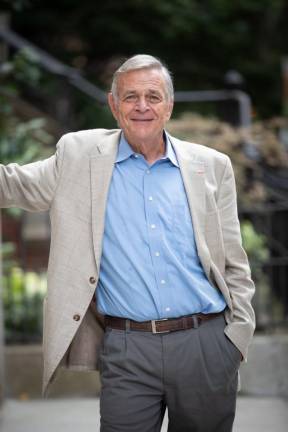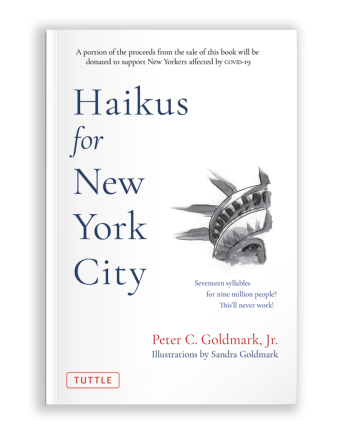Colson Whitehead once wrote that we each start building our own private New York the first time we lay eyes on it. Which affirms the existential truth of that cop show which each week offered us one of the “eight million stories in the Naked City.”
From Walt Whitman to E.B. White (and, of course, Colson Whitehead), New Yorkers have worked to distill from this immensity the essence of their city.
Writers riff off New York endlessly, including the time the New York Post invoked the “Naked City” after an intrepid New Yorker stole the cladding from a cast iron building in lower Manhattan.
There are eight million stories in New York, the Post told us, but today there are five fewer.
In “Haikus for New York City,” Peter Goldmark scatters a bit of that distinctly New York wit amidst a passion for his city. The Haiku form, poems in 17 syllables, turns out to be surprisingly suited to the staccato rhythms and rushing fragments from which each of us builds our own private New York.
No matter how fast you walk
in New York
someone always
strides past you.
(Note: in the original text, there is a more varied layout to the poems.)
A legendary state official, publisher and environmentalist, Goldmark said he had been writing poems for some forty years (he turned 80 last December), mostly to make personal sense of the world. Four years ago he began composing Haiku.
“I liked the puzzle like assembly of short, measured pictures of and insights into the large, multi-dimensional city I call home,” he explained. A friend urged him to publish the poems, which Tuttle Publishing has done, with illustrations by his daughter, Sandra, an illustrator and Associate Professor of Theatre Practice at Barnard College.
In every pivot of his haikus, Goldmark shows he has our number because he is one of us.
Ever go one entire day
crossing only
at the green?
He adopted this new discipline of Haiku just as “both our country and our city came under stress,” Goldmark recalled.
Covidiously empty
Streets,
Shutters,
Locks
--our old city is ill.
“All this made me realize how much I loved and valued my city — its beauty, its diversity, its remarkable people, its grit and resilience ... and how fragile and unique it was.”
Many of his poems describe an eternal New York, almost as if he could will its recovery:
Rivers,
traffic,
fashion,
news,
investment
--things never stop flowing here.
Except of course when they do. One stanza is almost nostalgic for a time when New Yorkers felt free to react to frustration like, well, New Yorkers.
“There is a train directly
behind this one.”
New York City bullshit.
Which he puts in context with:
Others think New Yorkers
are wise-asses.
We’re just being descriptive.
These familiar acts of New York resilience, stand in this volume beside the deep pain of the pandemic. Goldmark honors frontline workers in one poem and in another expresses the familiar yet uneasy feeling of eye contact with fellow New Yorkers left on the street:
Hope?
Despair?
Forced courtesy?
Glances from the homeless
on the sidewalk.
“Magic Place”
Goldmark was born on the East Side and thus first laid eyes on the city as a small child. Central Park was a “magic place,” he recalled. Uncles were in uniform going off to war and, on his first day of nursery school, a larger boy slugged him with a block. “A good example of the surprises and even unpleasant violence you can be exposed to in NYC,” he remembered all these years later.
Between then and now he has served as the New York State Budget Director (where this correspondent first met him), executive director of the Port Authority, the head of the Rockefeller Foundation, the leader of the Environmental Defense Fund’s air and climate program and the publisher of the International Herald Tribune and a vice president of Times-Mirror Co. when it owned Newsday.
The Goldmark encountered by New Yorkers through his many positions was erudite and insightful – and rarely short of words to surround the challenge of the moment, be it “riots, strikes, once a hostage situation.”
“Pressure and crisis can harden and numb you if you do not have a way to find meaning in your life, if you do not remain free to think and to experience all sorts of feelings.”
That more familiar Goldmark of the mind recedes here. Reading a Goldmark Haiku is more or less as surprising as seeing a George W. Bush painting. Who knew they could do that?
Just as Bush surprised us with his portraits of immigrants, now Goldmark, his words shorn to a minimum, evokes the chasm between our own private New Yorks and the city we inhabit together.
Tragically we’re missing
A stethoscopic imagination.
Otherwise we could hear
The deafening drumroll
Of nine million hearts.
This is a tough place, Goldmark repeatedly acknowledges.
New York City does not often
gently calm you down,
reach out and heal.
Yet, through all 41 of his poems, Goldmark offers empathy to his fellow New Yorkers and a faith in the place.
You can’t rush it or chase it.
But sometimes in New York
peace will find you.

